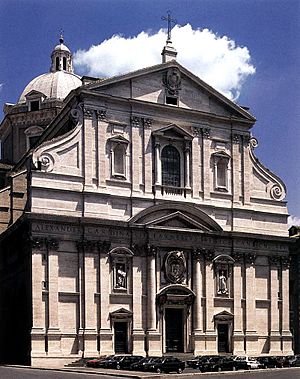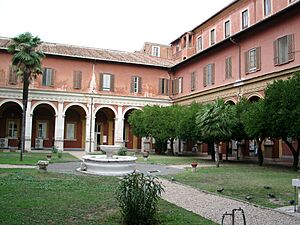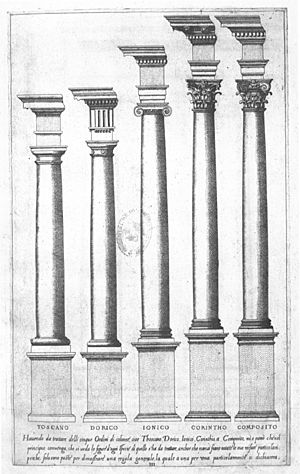Giacomo Barozzi da Vignola facts for kids
Quick facts for kids
Vignola
|
|
|---|---|

Giacomo Barozzi da Vignola
|
|
| Born |
Jacopo Barozzi da Vignola
1 October 1507 Vignola, Duchy of Ferrara (present-day Italy)
|
| Died | 7 July 1573 (aged 65) |
| Nationality | Italian |
| Known for | Architecture, Garden design |
|
Notable work
|
Villa Farnese Church of the Gesù Villa Lante |
| Movement | Mannerism |
Giacomo Barozzi da Vignola (born October 1, 1507 – died July 7, 1573), often simply called Vignola, was a very important Italian architect. He lived in the 16th century during a period called Mannerism. This was a style of art and architecture that came after the High Renaissance.
Vignola created two famous buildings. These are the Villa Farnese in Caprarola and the Church of the Gesù in Rome. He is one of three architects who helped spread the Italian Renaissance style across Western Europe. The other two were Serlio and Palladio. Many people see Vignola as the most important architect in Rome during the Mannerist time.
Biography
Jacopo Barozzi was born in a town called Vignola, near Modena in Italy.
He started his career as an architect in Bologna. In 1536, he traveled to Rome. There, he made detailed drawings of old Roman temples. He hoped to publish a book about them. From 1541 to 1543, he worked for King Francis I of France in Fontainebleau. He likely met other artists there, like the architect Sebastiano Serlio and the painter Primaticcio.
After returning to Italy, he designed the Palazzo Bocchi in Bologna. Later, he moved to Rome. In Rome, he worked for Pope Julius III. After the Pope died, the powerful Farnese family hired him. He also worked with the famous artist Michelangelo, who greatly influenced his style.
In 1558, Vignola went to Piacenza. He was asked to update the designs for the Palazzo Farnese there. This project was for Margaret of Austria. She was the wife of Duke Ottavio Farnese.
From 1564, Vignola continued Michelangelo's work on St. Peter's Basilica in Rome. He built two smaller domes based on Michelangelo's plans.
Jacopo Barozzi died in Rome in 1573. In 1973, his remains were moved and reburied in the Pantheon, Rome.
Works
Vignola designed many important buildings. Here are some of his main works:

- Project for the facade of the Basilica of San Petronio (around 1545), in Bologna.
- Villa Giulia for Pope Julius III, in Rome (1550‑1553). Vignola worked with other artists here. They designed parts of the villa and its gardens.
- Villa Farnese at Caprarola (1559–1573). This is one of his most famous works.
- Villa Lante at Bagnaia (from 1566 onwards). This includes beautiful gardens with water features.
- Church of the Gesù in Rome. This church became a model for many Baroque churches built later. The Baroque style is known for its dramatic and grand designs.
- Church of Sant'Andrea in Via Flaminia, Rome. This was the first church to have an oval dome. This shape became very popular in the Baroque period.
- Palazzo Farnese, Piacenza. This was a huge palace project. It was meant to be one of the largest palaces in Italy. However, only less than half of Vignola's original plan was built.
- St. Peter's Basilica in the Vatican. Vignola became the main architect after Michelangelo died.
- Orti Farnesiani on the Palatine Hill in Rome. These were gardens for the Farnese family.
- Church of Sant'Anna dei Palafrenieri in Vatican City (around 1570). This church also featured an oval dome within a rectangular plan.
Other notable works

- Temple in the Park of the Monsters in Bomarzo.
- Church of San Marco in Caprarola.
- Palazzo Ducale in Gallese.
- Piazza Umberto I and the Fountain of the Spades in Oriolo Romano.
- Palazzo Altieri in Oriolo Romano.
- Church of Santa Caterina dei Funari in Rome.
- Palazzo Borghese in Rome.
- Palazzo Farnese (Rome) in Rome.
- The main courtyard of the Pontifical University of Saint Thomas Aquinas in Rome.
- Porta del Popolo in Rome.
- Palazzo Bocchi (1545) in Bologna.
- Palazzo Boncompagni in Bologna.
- Palazzo del Giardino in Parma.
Written works
Vignola wrote two important books. These books helped set the rules for classical architectural style.
His first book was Regola delli cinque ordini d'architettura (published in 1562). This book showed a practical way to build columns using the five classical styles: Tuscan, Doric, Ionic, Corinthian, and Composite. Vignola based these proportions on his own measurements of ancient Roman buildings. This book was very clear and easy to use. Because of this, it became the most published book in architectural history for centuries!
Vignola's second book was Due regole della prospettiva pratica ("Two rules of practical perspective"). It was published after he died, in 1583. This book explained how to draw things in one-point perspective. It showed practical ways to use perspective that people could easily understand.
See also
 In Spanish: Jacopo Vignola para niños
In Spanish: Jacopo Vignola para niños



